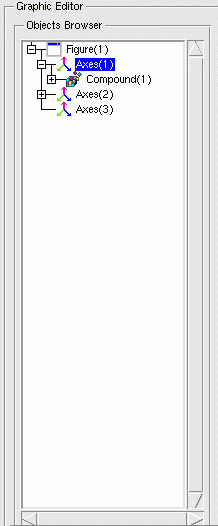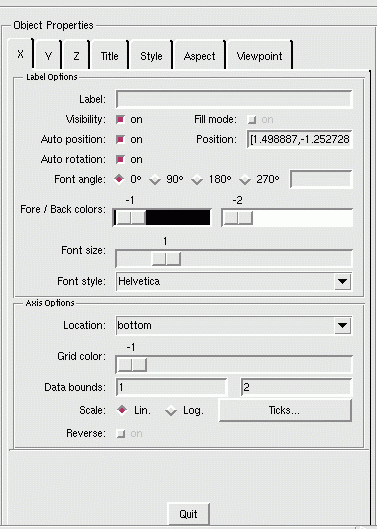Scilab Data type
Last update : 14/2/2006
object_editor - description of the graphic object
editor capacities
graphic - description of the graphic object editor
capacities
menus - description of the graphic object editor
capacities
Description
As explained in the
graphics_entities
help file, Scilab
graphics is now based on a brent new graphics mode. This mode allows the
user to have more interaction with graphics before and after having them
drawn. In the
"new"
mode, each graphics window and the
drawing it contains are represented by hierchical entities. The hierachy
top level is the Figure. Each Figure defines at least one child of type
Axes. Each Axes entity contains a set of leaf entities which are the basic
graphics objects like Polylines, Rectangles, Arcs, Segs,... It can also
contain a Compound type which are recursive sets of entities.
The main interest of the new graphic mode is to make property changes
easier. This new graphics'mode provides a set of high-level graphing
routines (see
set
,
get
) used to control objects'
properties such as data, coordinates and scaling, color and appearences
without requiring to replay the initial graphics commands.
Graphics entities are associated to Scilab variables of type
handle
. The handle is a unique identifier which is associated
to each instance of a created graphical entity. Using this handle, it will
be possible to reach entities' properties through "set" and "get"
routines. The handles are also used to manipulate graphics objects, to
move them, to make copies or delete them.
To complete and use the graphics handle capacity at its maximum, a
graphic object editor has been created too. It is a set of Tcl/Tk
interfaces available for each kind of graphics objects (see
graphics_entities
for more details) that can be enabled for
each graphic window. To make it work, select the
Edit
menu in
the graphic window. Seven graphics editing operations are available :
-
Select figure as current: Let thisfigure be the current one.
-
Redraw figure: Redraw the content of the graphics window (only useful for
old_style mode).
-
Erase figure: Erase the content of the graphics window. Its action corresponds
to a
xbasc
(old graphic style) or
clf
(new
graphic style) command.
The last eight items are specially dedicated to the graphic editor
:
-
Copy object: Using the mouse, it allows the user to select a 2D object (like a
curve, a rectangle...) and put it in the clipboard. Thus, by a next
call to
Paste object
, the object is copied in the
selected current axes.
-
Paste object: Allow the user to paste a previous object put into in the
clipboard inside the selected current axes.
-
Move object: Using the mouse, it allows the user to move a 2D object (like a
curve, a rectangle...) inside the selected current axes.
-
Delete object: Using the mouse, it allows the user to pick up a 2D object (like a
curve, a rectangle...) inside the selected current axes and to delete
it instantly.
-
Figure Properties: Launch the Tcl/Tk interface for the Figure object applied to the
figure handle of the graphics window.
-
Current Axes Properties: Launch the Tcl/Tk interface for the Axes object applied to the
current axes handle of the graphics window.
-
Start Entity Picker: Start an event handler on the graphics window to catch the mouse
clicks on graphics objects and launch the corresponding Tcl/Tk
interface. The left mouse-click allows object edition and the right
click performs a move of the selected object. Note that, for now, this
feature is applied to 2D objects only.
-
Stop Entity Picker: Stop the action of the Entity Picker by terminating the event
handler on the graphics window.
Once the graphic interface is enabled (using the
Figure
Properties
or
Current Axes Properties
options), two
main areas appear :
-
A tree selector: Placed on the left side of the graphical editor, a hierarchical
tree selector specifies which object is currently edited. It can be
used to switch from a graphic object to another provided that they are
in the same graphic window.

-
A notebook: The second area represents a notebook composed with different
properties pages (like
Style
,
Data
,
Clipping
...) depending on the selected graphic object.
Using this editor, man can edit more easily the whole properties set
of each graphic object (like through the
"set"
and
"get"
commands). Here is an example of the axes' notebook
displaying axes properties:

See Also
graphics_entities
,
set
,
get
,
clf
,
plot
,
Author
F.Leray INRIA


